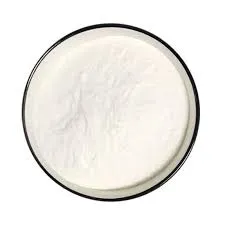
Samh . 04, 2024 04:57 Back to list
hydroxypropyl methyl cellulose ether
Hydroxypropyl Methyl Cellulose Ether An Overview
Hydroxypropyl methyl cellulose (HPMC) ether is a widely used synthetic polymer derived from cellulose. As a non-ionic cellulose ether, it is characterized by its ability to dissolve in cold water and form viscous solutions. These properties make HPMC a valuable ingredient across various industries, including pharmaceuticals, food, cosmetics, and construction.
The chemical composition of HPMC involves the substitution of hydroxyl groups in cellulose with hydroxypropyl and methyl groups. This modification greatly enhances the solubility and thermal stability of cellulose, allowing HPMC to maintain its characteristics in a range of pH conditions and temperatures. The degree of substitution can be adjusted during production, leading to different grades of HPMC that cater to specific applications.
In the pharmaceutical industry, HPMC serves as an excipient, a substance that facilitates drug formulation. Its water-soluble nature allows for the creation of controlled-release drug formulations. This is essential for medications that require a gradual release of active ingredients into the bloodstream, enhancing their efficacy and reducing side effects. HPMC is also used as a thickening agent in topical and liquid formulations, bolstering the stability and texture of various products.
In the food industry, HPMC is recognized for its ability to act as a thickener, emulsifier, and stabilizer. It is commonly used in products such as sauces, dressings, and bakery items. HPMC helps to improve the mouthfeel and texture of food products, contributing to an enhanced sensory experience for consumers. Furthermore, as a plant-derived ingredient, HPMC is favored in the production of gluten-free and vegan foods, appealing to a broader range of dietary preferences.
hydroxypropyl methyl cellulose ether

The cosmetic industry also benefits from HPMC’s versatile properties. It is frequently incorporated into skin care and hair care products due to its film-forming abilities and its capacity to retain moisture. HPMC contributes to the smooth application of creams, gels, and lotions while also providing an aesthetic appeal, making products feel luxurious and pleasant during use.
In construction, HPMC is utilized as a water-retaining agent in cement and gypsum-based materials. Its inclusion enhances workability, improves adhesion, and prolongs the setting time of building materials, all of which are vital for achieving durable and high-quality constructions. HPMC also serves to reduce cracking and shrinkage in mortars and plasters, promoting structural integrity.
Beyond its practical applications, HPMC is considered a safe ingredient in consumer products. It is non-toxic and biodegradable, raising its profile as an environmentally-friendly choice in various formulations. Given its safety and versatility, the demand for HPMC continues to grow as industries seek effective and sustainable solutions.
In conclusion, hydroxypropyl methyl cellulose ether stands out as a multifunctional ingredient with a diverse range of applications. From pharmaceuticals to food, cosmetics, and construction, HPMC demonstrates remarkable properties that not only enhance product performance but also cater to consumer demands for safety and sustainability. As industries evolve, HPMC will likely continue to play a pivotal role in innovative formulations and applications, making it an essential compound in modern production processes.
-
Versatile Hpmc Uses in Different Industries
NewsJun.19,2025
-
Redispersible Powder's Role in Enhancing Durability of Construction Products
NewsJun.19,2025
-
Hydroxyethyl Cellulose Applications Driving Green Industrial Processes
NewsJun.19,2025
-
Exploring Different Redispersible Polymer Powder
NewsJun.19,2025
-
Choosing the Right Mortar Bonding Agent
NewsJun.19,2025
-
Applications and Significance of China Hpmc in Modern Industries
NewsJun.19,2025







